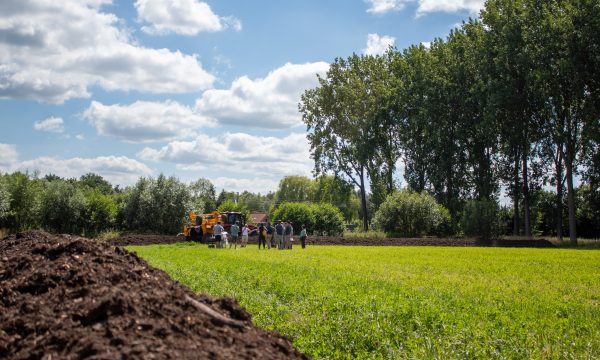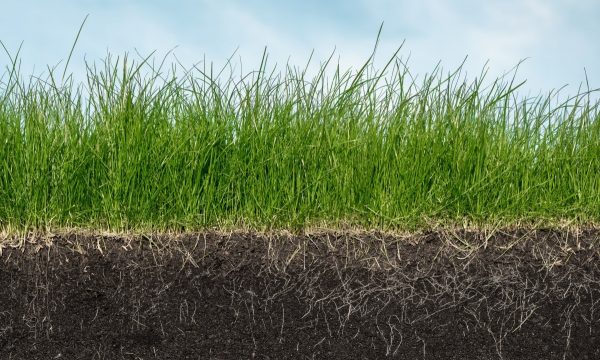Press release Determining soil health over time via 'microscopic soil life' indicator? PhD shows unexpected confirmation
An extremely diverse community of microorganisms such as bacteria and fungi, called the soil microbiome, live an active life in the soil. There is a link between this microbiome and soil health. However, how this fits together has not yet been fully unraveled.
During her PhD, ILVO-UGent researcher Lisa Joos analyzed a large series of soil samples from field trials with different, known histories, using both chemical and DNA- and RNA-based methods. The study brings soil science one step closer to a microbiome indicator of soil health.
"First, it appears that sampling per se (time, depth and location within a field) has a strong influence on the composition of the soil microbiome, making interpretation of an analytical result complex. Second, it seems that the composition or presence of certain types of microorganisms are not immediately able to indicate the degree of soil health. In contrast, perhaps the magnitude of the microbiome response to an administered stress can provide the basis for an indicator of soil health."
Getting such a soil health test confirmed and validated as a measurement tool still takes considerable research.
Unique approach: many soil microbiome analyses and widely distributed sampling
Soil is a complex, living system. ILVO and others have been studying the effect of agricultural practices on soil health for decades. But it remains unclear which biological parameters measure this reliably, precisely and smoothly. Currently, the number of earthworms present is counted, for example, or the number of certain types of nematodes or fungi. This research opted to take a remarkably large number of different soil samples and determine the complete microbiome, in the hope of eventually arriving at a microbiome indicator for soil health. The samples were taken over a period of time (every 5 weeks throughout the year), at different depths and from several trial fields that differed in soil health and each had received a different organic additive.
Analytical methods used for the soil microbiome
To determine this soil microbiome, Joos used both standard chemical analysis techniques and more novel DNA/RNA-based techniques. A first standard chemical technique is PLFA (PhosphoLipid Fatty Acids). Since the composition of fatty acids in various soil organisms differ, the biomass of microorganisms present in the soil can be measured by the PLFA (PhosphoLipid Fatty Acids) method. HWC (hot water extractable carbon) is the second chemical method used to determine carbon-based microbial biomass. These two techniques were compared with high-throughput DNA and RNA-based sequencing techniques such as metabarcoding and metatranscriptomics. Here, a fingerprint (barcode) is made of all organisms present in the soil sample being tested, but the identification of the organisms is much more detailed.
Time of sampling affects composition of soil microbiome
Many studies on soil microbiome base their story on one or a very limited number of time points. Now it turns out that the timing of sampling during the season brings about important changes in the soil microbiome so that effects of organic additives such as compost or biochar (stable, inert carbon) on the soil microbiome can be masked by the timing of sampling.
Lisa Joos: "In the field where a single dose of biochar had been applied 10 years ago, I observed a stable soil microbiome over the year. The field where compost was applied annually did show stronger changes in the microbiome composition. With an important nuance: the largest observed fluctuations were related to the timing of soil sampling, not the organic applications."
Location and depth of sampling affects composition of soil microbiome
Another remarkable observation occurred when comparing the soil microbiome analyses from the four control plots. Control plots are fields that do not undergo any treatment in an experimental design. The hypothesis was that the soil microbiome of these four control plots would be quite similar among themselves. "On the contrary, the analytical results differed greatly among themselves in terms of composition, regardless of which time point was studied, while thus receiving the same 'zero regime' and sometimes being less than 40 meters apart."
A comparison of the soil microbiome at two depths, namely 0-10 cm and 10-30 cm also yielded strong differences in the analytical results: the upper layer is more exposed to a variety of environmental factors, perhaps resulting in stronger variability over time than when sampling deeper.
The large number of measurements brought the insight that soil microbiome is susceptible to multifactorial variability. Consequently, the procedure surrounding soil sampling is important to make meaningful comparisons or models afterwards. If the time, place and depth are not accurately recorded, you don't know how large the margin of error is on statements about soil health. "Second, we should be wary of making conclusions based on little or only one metabarcoding analysis of one sampling time, depth or location."
A hypothesis: adaptivity after administered stress
From that observation, the researcher took a step toward an incubator test. With that, you exclude environmental factors that cause noise in field observations. Under controlled conditions, you expose the soil microbiome to stressors, recording very precisely the state before and after the stress and comparing the two scores.
The "administered stress experience" consisted of three consecutive treatments:1. wetting (to emulate a sudden large rainfall),
2. subjected to drought,
3. addition of the inert organic substance chitin, a powder based on exoskeletons of insects or crustaceans.
"I then linked the degree of change to the soil health of the soils studied, from the hypothesis that the soil microbiome responds more sensitively to stress in a less healthy soil. The more unhealthy the soil, the more changes in the composition of the microbiome."
The results of the incubator test before and after stress confirmed the hypothesis surprisingly well. The magnitude of change in the soil microbiome before and after stress correlated very well with the already known soil health.
Conclusion: adaptability appears to be better indicator than composition of microbiome per se
In the incubator test of this PhD, the soil microbiome from the healthy soils showed fewer shifts after each stressor, compared to the microbiome from the unhealthier soils. The magnitude of the response of the soil microbiome to short-term disturbances correlates nicely with the degree of soil health.
Researcher Lisa Joos concludes, "It is not the nature of the soil organisms, but rather the resilience of that total community of bacteria and fungi in the face of external stresses that I think has a chance of becoming a new indicator of soil health."
Dr. Jane Debode, one of two ILVO co-promoters: "Of course, no definitive conclusions can be drawn based on the limited amount of soils studied. Through many replications on other soils and in other growing conditions, this method still needs to be further developed and validated. But we do now have an interesting direction to take."
Dr. Caroline De Tender, promoter at Ghent University: "The incubator disruption test' has now been tested on two soils and the duration of the disruption was quite long (5 weeks). Now we can look for a faster disruption. The first step toward a robust biological indicator of soil health based on a soil microbiome response-after-stress has been made."
Contact
Dr. Lisa Joos, author of thesis on the soil microbiome and soil health at ILVO/Ugent, Lisa.Joos@UGent.be, T. +32 478 652915
Dr. Bart Vandecasteele - expert on soil research at ILVO and co-promotor of Lisa Joos - bart.vandecasteele@ilvo.vlaanderen.be


